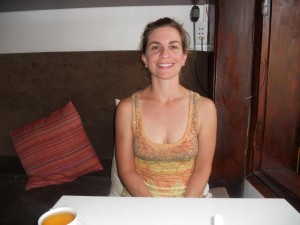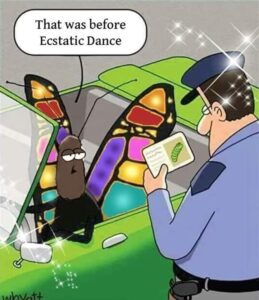
Sarah Kreisman
Ecstatic Dance: A Healthy Community Model, by Sarah Kreisman
There exist an endless variety of styles and types of communities in the world today. Some are large, some small in size, some are fleeting and some have existed for many generations. Forming into community is a part of human nature. “Our attraction to groups is instinctual; two hundred thousand years of human history have formed us into the group creatures we are” (Bellman, G. & Ryan, K., 2009, p.14). It is true that perhaps all communities in existence are not healthy communities, but there exist many which by nature are good for the people who are within them, as well as for those who are without. The ecstatic dance community is one great example of a healthy community. As a result of its unique nature, shared leadership and relationship to art, the ecstatic dance community is an excellent model of a successful, sustainable community.
There are many elements to the ecstatic dance community which make it unique from the majority of the communities in the world. The community as a whole is very openly loving and passionate in a way that I have never before witnessed. Affection is accepted and even encouraged between men. The community in general focuses strongly on human connection, on facing fears and learning to love and be loved. As community elder Bob Czimbal says, “we are more focused on belonging than belongings” (B. Czimbal, personal communication, August 15, 2013). The emphasis is on embracing truths and being accepted and embraced for doing so. The social norms are to be wild, free, sober and respectful. Czimbal states, “the goal is to increase passion and consciousness simultaneously as opposed to the typical increase in passion and decrease in consciousness correlation” (B. Czimbal, personal communication, August 15, 2013).
I myself have been experiencing the dynamics of the ecstatic dance community as a member for almost five years. During this time I have had the pleasure of befriending Bob Czimbal, a member of the community since 1996. Czimbal has been a community activist since the 1960’s when he began to participate in “human potential” movements. These movements involved an aspect of personal growth and healing which was unique and radical for the times. Czimbal participated as the greater community of the United States came together over external issues such as the Vietnam War. This experience motivated him to begin on his life’s path of merging the concepts of personal growth and community. Czimbal received a Bachelor of Arts in Sociology, went on to study community and co-authored Vitamin T and Kindred Spirits with his wife Maggie Zadikov.
Bob Czimbal, as a result of his passion for creating community and teaching others to do the same, has inadvertently become a strong pillar of the community. He has taught many seminars and workshops, and facilitated many gatherings which teach and encourage respectful communication and touch. Czimbal’s primary leadership role in this community has been in helping community members to develop these healthy skill sets as well as teaching them how to form a community of choice. Overall, Czimbal has played a pivotal role in helping the ecstatic dance community to remain healthy and prosper.
The benefits of being a member of the ecstatic dance community are many. When participating in ecstatic dance, we have the opportunity to witness and observe various behavior models and learn from them. The dance space provides an experimental environment which enables people to practice various ways of interacting with others in order to discover new and different manners of relating and setting boundaries. People are able to experience deep connection with each other without fear of expectations or attachments. It’s an environment which gives people the opportunity to learn to feel comfortable with touch and experience an embodied sense of spirituality. The community is also a playful space for people of all ages, encouraging joy, humor and a youthfulness which is uncommon in most adult communities. According to author David Richo, author of How to be an Adult in Relationships: Five Keys to Mindful Loving, there are five necessary elements to having healthy, loving adult relationships: attention, acceptance, appreciation, affection and allowing. This theory applies to any relationship experienced in adulthood. “They are the components of the healthy ego: Attention from others leads to self-respect. Acceptance engenders a sense of being inherently a good person. Appreciation generates a sense of self-worth. Affection makes us feel lovable. Allowing gives us the freedom to pursue our own deepest needs, values, and wishes” (Richo, 2002, p27). As depicted in the description of the ecstatic dance community, it is clear that an environment is created in which the five keys are facilitated. This creates a space of healing and nourishment which individuals may or may not be experiencing outside of this community.
All of the aforementioned benefits are aspects which promote good emotional and psychological community health. Strong friendships and even business partnerships form out of this community, creating concrete social capital for its members. “…Social capital refers to connections among individuals- social networks and the norms of reciprocity and trustworthiness that arise from them” (Putnam, 2000, p.19). With a high level of social capital, community and individual needs are well-supported, leading to an exceptional commitment and participation within the community by its members. Trust and reciprocity are incredibly important factors which attribute to community health and cohesion. “In short, people who trust others are all-round good citizens, and those more engaged in community life are both more trusting and more trustworthy” (Putnam, 2000, p.137). The ecstatic dance community by nature creates and encourages a community of trusting, inter-dependent individuals who are able to take the lessons they learn in this space and apply them in their lives within the greater, surrounding community. According to Czimbal the ecstatic dance community is “the most cutting edge spiritual evolution and revolution in the world today” (B. Czimbal, personal communication, August 15, 2013).
The leadership model in the ecstatic dance community is interesting as well as effective. The community functions in a democratic style, focusing on equality, shared leadership and decision-making within the group. This community functions succesfully as a team, with a structure of varying leadership roles depending on individual’s skill sets and interests. This style of power distribution is part of what makes this community sustainable. In Spencer Klaw’s book Without Sin: The Life and Death of the Oneida Community, we get a close look at an intentional community which existed successfully for 33 years in the late 1800’s. This was a “tightly knit and thriving society of some three hundred Christian communists living in upper New York State” (Klaw, 1993, p.1) who united under a leader who was a charismatic, self-proclaimed divine authority. This group practiced “complex marriage”, had a strong educational ethic, work ethic, and commitment to a leader whom they believe was leading them on the path to the Kingdom of Heaven. “…in a community of true Christians, God did not intend that love between men and women should be confined to the narrow channels of conventional matrimony. All the men at Oneida were therefore considered to be married to all the women” (Klaw, 1993, p.3).
John Noyes, the founder and leader of the Oneida community, ruled in the authoritarian leadership style, keeping tight control over the habits and practices of his community members. This was an effective method of leadership in that it created a large, cohesive, lucrative, community, but given the temporary existence of the community, it clearly was not sustainable. Once the community members began to lose faith in Noyes and his ideals, it wasn’t long before the community itself dissolved. “The Community’s founders had shared, and been united by, the exhilarating conviction that they were a chosen people; having freed themselves from sin, they could look forward to achieving immortality in their own lifetimes” (Klaw, 1993, p.233). The dream slowly died, Noyes lost his credibility, the community divided and ultimately disbanded. This is a great example of how tenuous the strength of a community can be in comparison to the solidity of the Democratic style of the ecstatic dance community.
Another aspect of the nature of this community which helps to make it a healthy, vibrant, sustainable community is its relationship to art. Humanity uses art for many purposes such as communication, entertainment, political/social expression, and healing to name a few. Within the ecstatic dance community art is commonly present. Whether via the medium of dance, musical performances or art exhibitions by community members, this community avidly supports and encourages artistic expression. There is a constant cycle of love, connection, support and creative expression flowing through this community. Through email list serves, social media and personal connections, when a community member offers to share their art publicly the community turns out to encourage, support and reward the courage of the vulnerable artist. The ambience is non-competitive, each person experiencing compersion when someone else succeeds. Artistic expression is celebrated, supporting the truth and freedom of each individual, yet another aspect of good health within this and other special communities.
Art has played an important role in many societies and social movements through human history, one of which was the Harlem Renaissance movement. This was a unique movement in the history of the African American culture in the United States, a movement which is world-renowned for the artistic expression which came out of it. “These years corresponded with an unprecedented artistic outpouring in the form of plays, novels, poetry, music, and visual art representing black life across many social categories- urban and rural, light skinned and dark, upper and lower class, male and female, heterosexual and homosexual” (Ferguson, 2008. p.1). During this movement African American people stood up and called for change. They shined a spotlight on their plight from slavery to segregation, and insisted on full social and political equality. Much of this communication was expressed through art. “The Harlem Renaissance holds a rightful place in African American memory as a time when freedom began to feel free” (Ferguson, 2008, p.2).
The ecstatic dance community parallels with the Harlem Renaissance movement in that it is also a very progressive, forward-thinking group, interested in social evolution and change. This community also uses art as a medium to express their desire for growth as we can see through ecstatic dance community member Eleanore O’Brien’s play series Inviting Desire. Her theatre company, Dance Naked Productions, “believes that the key to human happiness lies in greater compassion and understanding (and of course, more and better sex), and use the medium of theater to further that goal” (O’Brien, 2012). O’Brien’s work is an excellent example of using art to create social change.
As outlined in this paper, because of its unique nature, shared leadership and relationship to art, the ecstatic dance community is an excellent model of a successful, sustainable community. It’s an inclusive model which welcomes the greater community to participate within and enjoy its norms and practices. As this community continues to grow and flourish over time, humanity in general stands to reap the benefits.
References
Bellman, G. & Ryan, K. (2009). Extraordinary Groups: How Ordinary Teams Achieve Amazing
Results. San Francisco, CA: Jossey-Bass.
Ferguson, J. B. (2008). The Harlem Renaissance: A Brief History of Documents. Boston,
MA: Bedford/St. Martin’s.
Klaw, S. (1993). Without Sin: The Life and Death of the Oneida Community. New York, NY:
The Penguin Group.
O’Brien, E. (2012). About Dance Naked Productions. Dance Naked Productions. August, 24,
2013, from https://dancenakedproductions.com/about-dance-naked-productions/.
Putnam, R.D. (2000). Bowling Alone: The Collapse and Revival of the American Community.
New York, NY: Simon & Schuster.
Richo, R. (2002). How to be an Adult in Relationships: Five Keys to Mindful Loving. Boston, MA:
Shambhala Publications, Inc.
Portland Ecstatic Dance – Video
The Sacred Circle Ecstatic Dance from a while back in the 90s – Village Ballroom days!









